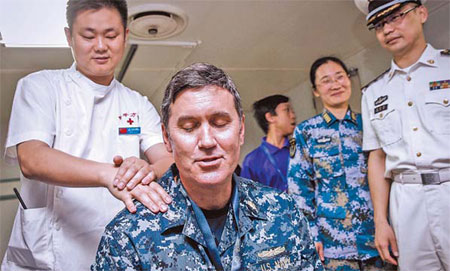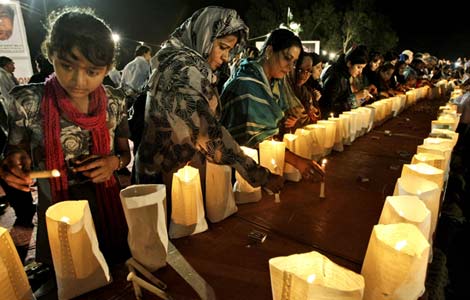Getting the point of Chinese medicine
Updated: 2013-06-25 06:57
By Peng Yining (China Daily)
|
||||||||
|
Erik Kuncir, a medical expert with the US navy, enjoys massage treatment by Chinese therapist Gu Wei on June 18 onboard Chinese hospital ship Peace Ark, which visited Brunei for a drill involving a number of countries including China and the United States. Zhang Hao / for China Daily |
|
Crew members of Peace Ark conduct an emergency rescue drill. Zhang Hao / for China Daily |
|
Gu Wei, one of the ship's Chinese medicine professionals, explains the theory behind cupping therapy. Zhang Hao / for China Daily |
Hospital ship carries cures across the sea, Peng Yining reports in Brunei.
Editor's note: On June 10, the Peace Ark embarked on a 118-day voyage to provide medical assistance to residents of neighboring countries and take part in joint operations and exercises with fellow members of ASEAN. This is the second report by China Daily's Peng Yining, who is aboard the vessel.
It was the first time that Nazaaha Ariqah had seen acupuncture.
With a lowered chin, the 12-year-old Bruneian girl watched as a Chinese doctor slid one-third of a 3-centimeter stainless steel needle into her mother's right ankle.
"Doesn't it hurt, Mom?" asked the girl. Noraini Nora just shook her head and smiled.
Nora had injured her ankle in a fall a couple of days before. When she heard on the local news that a Chinese hospital ship had anchored in Brunei and was providing free medical treatment, including traditional Chinese therapies, she came along immediately.
"I've heard how amazing Chinese medicine is for a long time," she said. "And now I finally have the chance to try it."
Brunei was the first stop on the 2013 Peace Ark mission. The hospital ship will visit eight countries across Asia to provide free medical services during the voyage, which lasts from June 10 to Oct 6. In addition to world-class Western medical equipment and staff, the ship's crew includes three specialists in traditional Chinese medicine.
"The Peace Ark mission is not only providing free medical services, but also providing a great opportunity for people worldwide to learn about China and Chinese culture," said Guan Bailin, deputy commander of the mission and head of the Chinese Navy's health department. "Chinese medicine can act as a bridge to connect people from different backgrounds."
After 10 minutes of treatment, Nora said the pain and swelling in her ankle had eased. "I felt a little jab when the doctor first put the needle into my ankle, but the treatment really works," she said.
Gu Wei, one of the ship's Chinese medicine professionals, said acupuncture relieves pain quickly, but the patient will need long-term treatment for the injury to heal completely. The Peace Ark can provide a variety of TCM treatments, including acupuncture, massage and cupping.
During the ship's five days at the port of Seri Begawan, it was visited by 1,300 residents and more than 100 of them received free health checks and treatment.
Tongue tied
The Chinese medicine consulting room, on deck five of the ship, was the most popular destination for patients. People crowded around the three doctors, watching as others were treated. Gu said dozens of people arrived every day and asked to try the therapies.
Suryanti Noor, who came for treatment on her sore shoulders and neck, had undergone acupuncture on the ship a few days before and was paying a second visit for more advice about her health.
"Please, show me your tongue," requested Gu. In response, Noor laughed out loud and, embarrassed, hid her face in her hands.
"To people who have never tried Chinese medicine before, it might seem strange that the doctor takes their pulse and asks to see their tongue," said Gu. "But the color and size of the tongue are good indications of the patient's health."
To explain the process, Gu poked about 2 cm of his tongue out of his mouth. He gestured for Noor to repeat his action, but the 37-year-old and other locals watching in the room just burst into laughter.
Some of the younger patients were wary of the treatment. "I would rather swallow a pill than be stabbed with a needle," said 13-year-old Shahronney Hassam.
The confusion and wariness didn't last long, though. "Most people understood eventually," said Gu.
Ethnic Chinese
The Chinese are no strangers to Brunei; indeed, 11 percent of the population is ethnic Chinese. "There is a large Chinese community and Chinese culture is very popular here," said Huang Shunping, a 52-year-old local resident, whose grandparents moved to the country from East China's Fujian province in the 1940s to work as woodcutters.
Life was tough for the first generation of immigrants and TCM was the only hope when people fell ill. That reliance saw the skills and culture passed down from generation to generation, according to Huang.
"I have been consulting doctors of traditional medicine in the local clinics my entire life," he said. "I'm happy that the Peace Ark has brought more doctors from the Chinese mainland."
Zhang Yinghong, president of the largest school in Brunei that teaches Chinese, said he was proud of the Peace Ark's visit. "It's a beautiful white ship and also a hospital, providing free medical care to the world," he said. "It spreads Chinese culture and traditions. Everyone with an ethnic Chinese background should be proud of it."
According to Guan, patients can choose between Chinese and Western treatments. The traditional therapies provided on the ship have been widely used in China for centuries and have been proven to be safe.
"The cost of Chinese medicine for commonplace illnesses is low, so it's suitable for people from developing countries and less-developed regions," he said.
A course of acupuncture treatment costs less than 50 yuan ($8) in China, and in Brunei a traditional massage costs about 20 Brunei dollars ($16), according to Cai Xiuwen, a 44-year-old TCM doctor. She moved to Brunei 12 years ago and runs a Chinese medicine clinic.
"My clinic and traditional treatment have received a warm welcome here. If that hadn't been the case I would have left long ago," she said.
Chinese medicine, especially acupuncture, is widely used by the various branches of the People's Liberation Army, according to Ding Yu, a TCM expert and acupuncture therapist on the Peace Ark. He said Chinese medicine will play an important role in the curing and prevention of disease and sickness during the 18,000-nautical-mile voyage.
"Ocean travel can affect people's heath in many ways. It's hot and humid on the ship and seasickness may result in a loss of appetite," he said. "The joints and muscles are in constant use as people try to maintain their balance, so many of them will feel sore and tired, despite not having to do much physical work. Moreover, there isn't a lot of room to exercise on a ship."
The limited onboard medical resources mean that TCM has an edge over Western medical practices. "TCM doesn't require high-tech equipment," said Ding. He used acupuncture as an example. "A doctor can do a lot, armed with just a packet of needles. TCM isn't as aggressive as Western medicine, but for many patients with chronic illnesses and pain, traditional Chinese treatment provides a great curative effect, but with far fewer side effects."
During the first two missions in 2010 and 2011, Peace Ark took Chinese treatments to nine countries in Africa, Southern Asia and South America.
Relief operations
On her visit to Brunei, the ship took part in a joint drill and disaster-relief operations held by the Association of Southeast Asian Nations Defense Ministers' Meeting Plus. It was the first time the Peace Ark had been involved.
People from a number of countries involved in the joint drill asked to visit the ship's TCM section, according to Wang Zhihui, director of the mission's medical crew.
During a combined "open deck" day, when the 18 member countries involved in the drill allowed free access to their vessels and held parties for the visitors, a dozen members of the Peace Ark crew performed Ba Duan Jin, a tai chi-like form of traditional Chinese exercise, which has been adopted by the sailors as a means of exercise during the voyage. Several crew and officers from the foreign ships enjoyed the performance so much that they joined in, as far as they were able.
"Many traditional Chinese treatments have been adopted by the United States' military," said Erik Kuncir, a US navy medical expert. At a meeting with Peace Ark officers, he mentioned that acupuncture is widely used by the US military to cure chronic pain.
"Its use is not as common as in China, but an increasing number of people in the US are becoming interested in Chinese medicine," said Kuncir. "I'm looking forward to greater cooperation with the Chinese military in this field."
Contact the writer at pengyining@chinadaily.com.cn
Ju Zhenhua contributed to this story.
(China Daily USA 06/25/2013 page8)
Most Viewed
Editor's Picks

|

|

|

|

|

|
Today's Top News
Berlusconi convicted on sex charges
US presses Russia over Snowden case
Xi: 'Exploration part of Chinese dream'
Chinese, Brazilian presidents discuss ties
China rejects Philippines' illegal seizure of reef
Immigration bill passes Senate vote
Liquidity squeeze bleeds equities
Surviving mountaineer in embassy
US Weekly

|

|


















